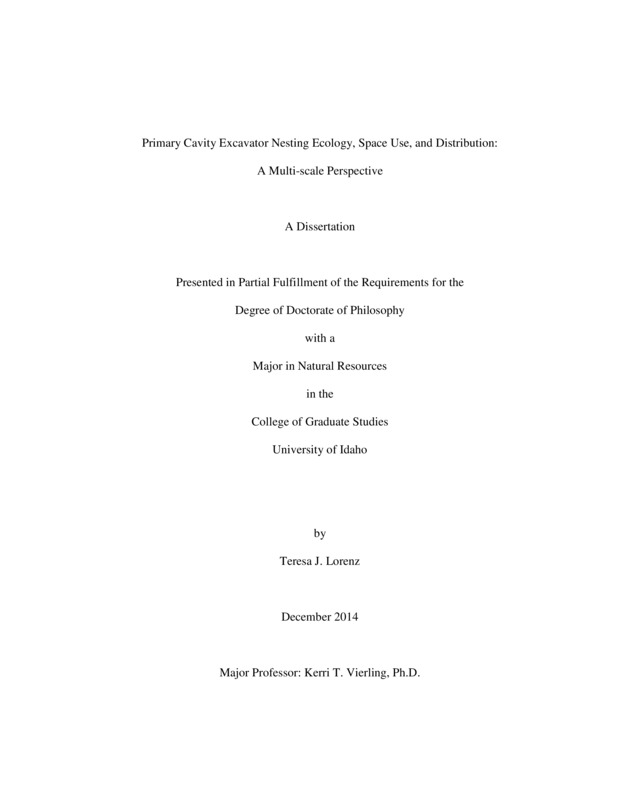Primary Cavity Excavator Nesting Ecology, Space Use, and Distribution: A Multi-scale Perspective
Lorenz, Teresa. (2014). Primary Cavity Excavator Nesting Ecology, Space Use, and Distribution: A Multi-scale Perspective. Theses and Dissertations Collection, University of Idaho Library Digital Collections. https://www.lib.uidaho.edu/digital/etd/items/lorenz_idaho_0089e_10451.html
- Title:
- Primary Cavity Excavator Nesting Ecology, Space Use, and Distribution: A Multi-scale Perspective
- Author:
- Lorenz, Teresa
- Date:
- 2014
- Program:
- Natural Resources
- Subject Category:
- Wildlife management; Animal behavior; Ecology
- Abstract:
-
Primary Cavity Excavators (PCEs) are an influential guild of animals that excavate cavities in trees for nesting and roosting. Vacated PCE cavities provide nest and shelter sites for a large number of animals - in some regions, up to one third of all species use or rely on PCE cavities. Thus, many species of PCE are considered ecosystem engineers and ecological keystones, and conservation of PCEs is important for biodiversity and ecosystem health. In this study, I explored nesting ecology, space use, and distribution of PCEs in the northwestern U.S.A. In chapter 1, I examined the role of wood hardness in limiting nest site selection. I found that interior wood hardness at nests differed from random sites, and nests of all species contained significantly softer interior wood than random trees. Accordingly, interior wood hardness was the most influential factor in nest-site selection by the six species I included in my study. In chapters 2 and 3, I focused on one at-risk PCE, the white-headed woodpecker (Picoides albolarvatus), and examined summer-fall ranging behavior and foraging ecology. I found that white-headed woodpeckers selected burned patches for their home ranges and varied their foraging behavior throughout the monitoring period. Overall, this study shows the importance of providing high densities of suitable snags for PCEs, even for live-tree foragers like the white-headed woodpecker. Snag management guidelines should be revised to take into account that large numbers of snags cannot be used for nesting by PCEs.
- Description:
- doctoral, Ph.D., Natural Resources -- University of Idaho - College of Graduate Studies, 2014
- Major Professor:
- Vierling, Kerri T
- Committee:
- Rachlow, Janet; Raphael, Martin; Svancara, Leona
- Defense Date:
- 2014
- Identifier:
- Lorenz_idaho_0089E_10451
- Type:
- Text
- Format Original:
- Format:
- application/pdf
- Rights:
- In Copyright - Educational Use Permitted. For more information, please contact University of Idaho Library Special Collections and Archives Department at libspec@uidaho.edu.
- Standardized Rights:
- http://rightsstatements.org/vocab/InC-EDU/1.0/

